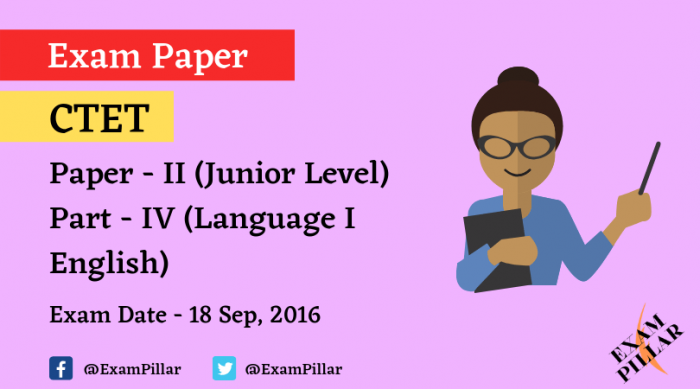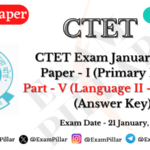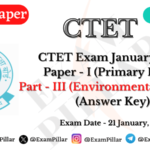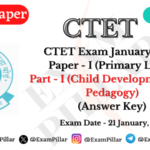CBSE conducted the CTET (Central Teacher Eligibility Test) Exam Paper held on 18th September 2016 Morning Shift. Here The CTET Language I English Solved Question Paper II (Class VI to VIII) Answer-key.
CTET (Central Teachers Eligibility Test) Paper Second : Junior Level (Class 6 to Class 8).
Exam : CTET Paper II (Class VI to VIII)
Part : Language I (English)
Organized : CBSE
Number of Question : 30
Paper Set – II
Exam Date – 18th September 2016
Read Also…
- CTET Sep 2016 Paper -II – Part – I – बाल विकास और शिक्षा-शास्त्र (Child Development and Pedagogy)
- CTET Sep 2016 Paper -II – Part – III – सामाजिक अध्ययन / सामाजिक विज्ञान (Social Studies/Social Science)
- CTET Sep 2016 Paper -II – Part – IV – Language – I हिंदी (Hindi)
- CTET Sep 2016 Paper -II – Part – V – Language – II (English)
- CTET Sep 2016 Paper -II – Part – V – Language – II हिंदी (Hindi)
CTET Exam September 2016 Paper – 2 (Junior Level)
Part – IV (Language I – English)
Directions : Answer the following questions (Q. Nos. 1 to 15) by selecting the correct/most appropriate options.
1. Language is a tool because :
(1) it is used for communication
(2) it is used for processing ideas
(3) it is used for thinking
(4) it is used for conveying ideas
Show Answer/Hide
2. Children can best learn a language when they have :
(1) a proficient language teacher
(2) inhibition
(3) motivation
(4) a good textbook
Show Answer/Hide
3. TBLT in second language teaching is :
(1) Task Book Language Teaching
(2) Tool-Based Language Teaching
(3) Task-Based Language Teaching
(4) Task-Based Language Training
Show Answer/Hide
4. The second language should be taught through:
(1) using the target language as much as it is possible
(2) mother tongue and translation
(3) learners’ background and talent
(4) grammar and rules of language
Show Answer/Hide
5. There are 44 sounds in English. Out of these, how many sounds are vowels and how many are consonants respectively?
(1) 5, 39
(2) 22, 22
(3) 10, 34
(4) 20, 24
Show Answer/Hide
6. A speech community refers to a community which :
(1) speaks different dialects
(2) uses different languages
(3) speaks the same language
(4) connects by virtue of a link language
Show Answer/Hide
7. Pedagogical grammar is :
(1) learning of meanings through form
(2) learning of rules first and then the meanings of words
(3) learning of grammar in context through use
(4) learning of grammar through prose and poetry
Show Answer/Hide
8. When learners have diverse linguistic backgrounds, the teacher should :
(1) form groups in accordance with their linguistic backgrounds
(2) ascertain their learning styles
(3) use multilingual approach
(4) start the class with brainstorming sessions
Show Answer/Hide
9. Which of the following ways is not appropriate for teaching a reading text?
(1) Teacher reads out and explains the text line-by-line.
(2) Learners are made into groups and asked to read by taking turns.
(3) Learners read individually and discuss with their friends the ideas of the text.
(4) Learners divide the text into small chunks and read.
Show Answer/Hide
10. Post-reading tasks are meant for :
(1) assessing the learning and connecting it to real-life situations
(2) giving the meaning of difficult words
(3) introducing the main idea of the text
(4) explaining the grammatical rules in the text
Show Answer/Hide
11. Intensive reading is aimed at helping the learners read a text for :
(1) improving study skills
(2) accuracy
(3) pleasure only
(4) information
Show Answer/Hide
12. Process writing approach could be described as :
(1) horizontal approach
(2) bottom-up approach
(3) top-down approach
(4) vertical approach
Show Answer/Hide
13. Abeera, an English teacher, describes a scene and asks the learners to draw what they have heard. This is a :
(1) picture story
(2) mutual dictation
(3) picture dictation
(4) picture composition
Show Answer/Hide
14. While teaching a ‘One-Act Play’, a tableau can be used as one of the teaching strategies. The tableau refers to :
(1) a monologue
(2) silent still image made by actors posing as characters
(3) some musical instrument
(4) dialogues between different actors
Show Answer/Hide
15. A teacher divides her class into pairs to exchange their notebooks and make corrections as per the direction of the teacher. What does she do?
(1) Group assessment
(2) Correction
(3) Assessment
(4) Peer assessment
Show Answer/Hide




